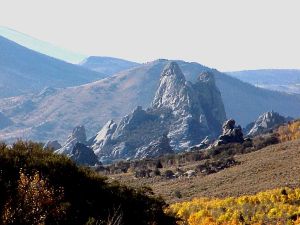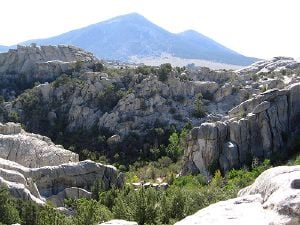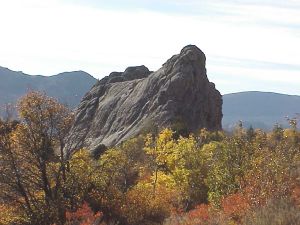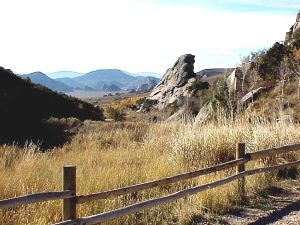Difference between revisions of "City of Rocks" - New World Encyclopedia
Mary Anglin (talk | contribs) m (→External links) |
Mary Anglin (talk | contribs) |
||
| Line 31: | Line 31: | ||
The [[California Trail]] passed through what is now the City of Rocks. Wagons trains of the 1840s and 1850s left the [[Raft River]] valley and traveled through the area and over Granite Pass into [[Nevada]]. The names or initials of emigrants written in [[axle]] [[grease (lubricant)|grease]] are still visible on Register Rock. Ruts from wagon wheels also can be seen in some of the rocks. | The [[California Trail]] passed through what is now the City of Rocks. Wagons trains of the 1840s and 1850s left the [[Raft River]] valley and traveled through the area and over Granite Pass into [[Nevada]]. The names or initials of emigrants written in [[axle]] [[grease (lubricant)|grease]] are still visible on Register Rock. Ruts from wagon wheels also can be seen in some of the rocks. | ||
| − | |||
| − | |||
| − | |||
| − | |||
| − | |||
| − | |||
| − | |||
| − | |||
| − | |||
| − | |||
| − | |||
| − | |||
| − | |||
| − | |||
| − | |||
| − | |||
| − | |||
| − | |||
| − | |||
| − | |||
| − | |||
| − | |||
| − | |||
==Environment== | ==Environment== | ||
| Line 97: | Line 74: | ||
===Soils=== | ===Soils=== | ||
The majority of the soils in the reserve are highly erodible. Wind and water erosion are the primary sources for erosion. Soil erosion is greatest near roads and on steep slopes and intermittent stream channels. Erosion in these areas has formed deep gullies. Some of the exposed soil banks are over 8 feet high. | The majority of the soils in the reserve are highly erodible. Wind and water erosion are the primary sources for erosion. Soil erosion is greatest near roads and on steep slopes and intermittent stream channels. Erosion in these areas has formed deep gullies. Some of the exposed soil banks are over 8 feet high. | ||
| + | |||
| + | ==History== | ||
| + | "We encamped at the city of the rocks, a noted place from the [[granite]] rocks rising abruptly out of the ground," wrote [[James Wilkins]] in 1849. "They are in a romantic valley clustered together, which gives them the appearance of a city." Wilkins was among the first wagon travelers to fix the name City of Rocks to what looked like "a dismantled, rock-built city of the Stone Age." [[California Trail]] pioneers were leaving civilization as they knew it in the East for new lives in the West. Some wrote their names in axle grease on rock faces, and their signatures can be seen today. No doubt thirsty on this northern edge of the [[Great Basin Desert]], one emigrant saw the distant rocks in August like "water thrown up into the air from numerous artificial hydrants." Beginning in 1843, City of Rocks was a landmark for emigrants on the [[California Trail]] and [[Salt Lake Alternate Trail]] and later on freight routes and the [[Kelton, Utah]] to [[Boise, Idaho]] stage route. | ||
| + | |||
| + | The area's historical and geological values, scenery, and opportunities for recreation led to its designation as City of Rocks National Reserve in 1988. This unit of the National Park System is managed cooperatively by the [[National Park Service]] and the [[Idaho Department of Parks and Recreation]]. | ||
| + | |||
| + | ===Native American history=== | ||
| + | The [[Shoshone]] and [[Bannock (tribe)|Bannock]] tribes hunted the [[American Bison|buffalo]] that once roamed in the City of Rocks area and gathered the nuts of the [[pinyon]] pine trees. The return of horses to the Americas in the 16th century and swelling European immigration disrupted the Shoshone-Bannock homelands and way of life. They grew to resent the intruders but could do little to stop them. Most emigrants on the California Trail saw no Native Americans, but some of their journals record smoke signals rising from high hills and the surrounding mountains. | ||
| + | |||
| + | In 1826, Peter Skene Ogden and his Snake River brigade of beaver trappers were the first non-Native Americans to note the City of Rocks. Having few [[beaver]], the area was ignored until 1843, when growing summer streams of wagons began flowing through the area. | ||
| + | |||
| + | ===California Trail=== | ||
| + | [[Image:City of Rocks Idaho North Fork Trailhead NPS.jpg|thumb|left|300px|The North Fork Trailhead in the City of Rocks National Reserve in Idaho State.]] | ||
| + | Early emigrant groups were guided by experienced mountain men such as Joseph B. Chiles and Joseph R. Walker. Later wagon parties followed the trails themselves, perhaps with the help of diary accounts of previous emigrants. The City of Rocks marked progress west for the emigrants and, for their loaded wagons, a mountain passage over nearby Granite Pass.<ref>Cassia CO. ID[http://www.topozone.com/map.asp?lat=41.9922&lon=-113.85&datum=nad27&u=4&layer=DRG&size=m&s=200]</ref> By 1846, emigrants headed for Oregon's Willamette Valley also used this route as part of the [[Applegate Trail]]. In 1848 Samuel J. Hensley<ref>[http://historytogo.utah.gov/utah_chapters/trappers,_traders,_and_explorers/thesaltlakecutoffandthecaliforniatrail.html The Salt Lake Cutoff and the California Trail<!-- Bot generated title —>]</ref><ref>[http://www.nps.gov/archive/ciro/hrs/hrs2e.htm City of Rocks NR: Historic Resources Study (Historical Development)<!-- Bot generated title —>]</ref>pioneered the Salt Lake Alternate Trail from [[Salt Lake City]] via Emigrant Canyon <ref>Cassia CO. ID[http://www.topozone.com/map.asp?lat=42.0217&lon=-113.673&datum=nad27&u=4&layer=DRG&size=m&s=200]</ref> to Granite Pass. In 1852, some 52,000 people passed through the City of Rocks on their way to the California goldfields. | ||
| + | |||
| + | When the trails opened in the 1840s, Granite Pass was in Mexico and less than a mile from [[Oregon Territory]]. After 1850 the Pass became part of [[Utah Territory]]<ref>Utah Northern border, the 42nd parallel[http://cprr.org/Museum/Utah_1851.html]</ref>, and in 1872 an Idaho-Utah boundary survey error<ref>[http://www.idahohistory.net/Reference%20Series/0126.pdf Microsoft Word - 0126.doc<!-- Bot generated title —>]</ref> placed Granite Pass in [[Idaho Territory]]. With completion of the [[transcontinental railroad]] in 1869, the overland wagon routes began to pass into history. However, wagons saw continued use on regional supply routes that spread out from the railroad lines. | ||
| + | |||
| + | John Halley's stage route connected the railroad at [[Kelton, Utah]] with Idaho's mining hub of [[Boise, Idaho]] and supplied the early economic development of Idaho, which won [[statehood]] in 1890. The [[Kelton stage route]] passed through the City of Rocks, with a stage station set up near the junction of the old California Trail and the Salt Lake Alternate. Settlers began to homestead the City of Rocks area in the late 1800s. Dryland farming declined during the drought years of the 1920s and 30s, but ranching survived. Livestock grazing began with early wagon use of the area in the mid-1800s and continues today. | ||
| + | |||
| + | ==Facts and designations== | ||
| + | The Idaho Legislature declared Section 36 within City of Rocks as a state park under the jurisdiction of the Idaho Lands Board on February 27, 1957. In 1964, a much larger areas was designated a national historic landmark. On March 15, 1973, Section 36 was transferred to the Idaho Department of Parks and Recreation from the Department of Lands. The following year, the area was designated a national natural landmark. The National Park Service studied the site in the 1970's and 80's as a proposed national monument. | ||
| + | |||
| + | City of Rocks National Reserve was created November 18, 1988 by Public Law 100-696, Arizona-Idaho Conservation Act of 1988. This Act drew a 22-mile boundary around 14,407 acres owned or managed by the USDA Forest Service, Bureau of Land Management, Idaho Department of Parks and Recreation (IDPR), and private individuals. All lands owned by the United States within the Reserve boundaries were placed under the authority of the National Park Service (NPS). Between 1988 and 1996, the Reserve was co-managed by both NPS and IDPR. After the approval of a comprehensive management plan, the NPS officially transferred on-site management of the Reserve to IDPR on May 2, 1996. Today, the park functions under a unique cooperative agreement between the NPS and IDPR. Both agencies allocate partial funding to its operation. City of Rocks National Reserve is visited annually by over 80,000 visitors. The Reserve headquarters is located in the gateway community of Almo. | ||
| + | |||
| + | |||
==Notes== | ==Notes== | ||
Revision as of 02:54, 17 November 2008
| City of Rocks National Reserve | |
|---|---|
| IUCN Category V (Protected Landscape/Seascape) | |
| | |
| Location: | Cassia County, Idaho, USA |
| Nearest city: | Oakley, Idaho |
| Area: | 14,107 acres (57.09 km²) |
| Established: | November 18, 1988 |
| Visitation: | 67,235 (in 2005) |
| Governing body: | National Park Service & Idaho Department of Parks and Recreation |
The City of Rocks or, more formally, the Silent City of Rocks is a U.S. National Reserve and state park lying two miles north of the south central Idaho border with Utah. It is widely known for its excellent sport climbing.
The rock formations in the area are granitic batholith. Some of the rock is over 2.5 billion years old. The Twin Sisters is a prominent rock grouping in the reserve.
The City of Rocks is a popular rock climbing area, with most routes being traditional climbs. A number of sport climbs have also been set. In the 1980s, it was home to some of the most difficult routes in the USA, mostly developed by Idaho climber Tony Yaniro.[citation needed] Sport climbers in the region refer to the area as simply 'The City'.
The California Trail passed through what is now the City of Rocks. Wagons trains of the 1840s and 1850s left the Raft River valley and traveled through the area and over Granite Pass into Nevada. The names or initials of emigrants written in axle grease are still visible on Register Rock. Ruts from wagon wheels also can be seen in some of the rocks.
Environment
City of Rocks, an extraordinary encirclement of granite rising out of the gently rolling sagebrush country in south-central Idaho, has attracted and intrigued people since they first entered this region. The Shoshone camped here as did the emigrants traveling along the California Trail. One of the reserve's most notable qualities is its large degree of biological diversity concentrated in a relatively small area. The great variety of textures, colors, and shapes in the natural landscape contributes considerably to the reserve's scenic quality.
Geologic formations
The landscape of City of Rocks has been sculpted from granite that was intruded into the crust during two widely spaced times. The granite that composes most of the spires is part of the 28 million year old Almo pluton. However, some of the spires are made of granite that is part of the 2.5 billion year old Green Creek Complex that contains some of the oldest rocks in the western United States. The granite has eroded into a fascinating assortment of shapes.
City of Rocks was designated a National Reserve, a unit of the National Park Service, in recognition of the nationally significant geological and scenic values of its rock formations and the historical significance of the California Trail. Rock formations in the reserve developed through an erosion process called exfoliation, during which thin rock plates and scales sloughed off along joints in the rocks. The joints, or fractures, probably resulted from contractions when the rock cooled or from expansions when overlying materials eroded away and eliminated confining pressure. The granite has eroded into a fascinating assortment of shapes as high as 600 feet. The upper surfaces of many of the rocks are covered with flat-floored weathering pits known as panholes. The most notable panhole is located on top of Bath Rock and is continuously filled with water from rain or snow melt.
Animals
The diverse habitat of the reserve supports a large variety of mammals, birds, reptiles, and invertebrates.
- Amphibians - Common amphibians that could be found near water include Boreal Toad, Great Basin Spadefoot Toad, and Northern Leopard Frog.
- Birds - The reserve provides excellent breeding and prey habitat for many raptor species including Golden Eagle, Prairie Falcon, Red-tailed Hawk, Northern Harrier, Sharp-shinned Hawk, Cooper's Hawk, American Kestrel, Turkey Vulture, and Great Horned Owl. Swainson's Hawk and Ferruginous Hawk are less abundant in the reserve. Other common bird species includes Sage Grouse, Pinon Jay, Clark's Nutcracker, Common Nighthawk, Rock Doves, Mourning Doves, Cliff Swallow, Mountain Bluebird, Hermit Thrush, Mountain Chickadee, Rock Wren, House Wren, Solitary Vireos, Warbling Vireos, Green-tailed Towhee, Virginia's Warbler, Brewer's Blackbird, and various Sparrows.
- Mammals - A partial list of mammals in the reserve includes, Mountain Lion, Mule Deer, Coyote, Bobcat, Badger, , Yellow-bellied marmot, Cliff Chipmunk, Mountain Cottontail Rabbit, , Black-tailed Jackrabbit, Snowshoe Hare, Northern Grasshopper Mouse, Merriam Shrew, several species of voles, and a variety of bats. Pronghorn antelope and bison were probably common a century ago.
- Reptiles - Typical lizard species include the western whiptail, western fence lizard, Long-Nose Leopard Lizard, Sagebrush Lizard, and Northern Desert Horned Lizard. Snakes include the Western Rattlesnake, Great Basin Gopher Snake, Striped Whipsnake, and Wandering Garter Snake. The Western Rattlesnake is the only strongly venomed snake found in the reserve.
Plants
Notable plantlife includes:
- The Kruckeberg's sword fern is found in the cool, moist micro-habitats in the granite formations. The fern grows in rock crevices and is normally found at higher elevations than City of Rocks. Primary threats to this species are trampling and or removal by visitors along rockclimbing routes.
- Stands of piñon / juniper woodlands are dominated by the single-leaf piñon pine and Utah juniper, interspersed with mountain big sagebrush and curleaf mountain-mahogany. The pinon seed is edible and gathered by local residents. Higher slopes are covered with mountain big sagebrush, snowberry, serviceberry, and bitterbrush, with other shrubs, grasses, and herbs growing in the openings between shrubs. Groves of aspen, stands of douglas-fir and lodgepole pine, are located on the upper stony / grassy slopes of the reserve. Quaking aspen groves occur in canyons containing streams.
Other dominant plants in the City of Rocks National Reserve include:
- Piñon / juniper woodlands and forest
- Conifer / aspen woodlands and forests
- Riparian scrub and herbaceous wetlands
- Big sagebrush and grasslands
- Mixed scrub
- Mountain mahogany scrubs
- High elevation meadows
- Other unvegetated areas
Weather
The semi-arid climate is characterized by low to moderate precipitation, great extremes in both daily and seasonal temperatures, and low relative humidity. Average annual precipitation is approximately 14 inches at the lower elevations and 22 inches in the highest areas. Average snow depths for higher elevations range between 35 and 68 inches. Summers are hot and dry with occasional thunderstorms.
Mountains
The reserve is in the southern part of the Albion Mountains, bordered on the east by the Raft River valley and to the north by the Snake River valley. Elevations rise from 5,650 feet where Circle Creek meets the reserve boundary to 8,867 feet at the top of Graham Peak to the north.
Soils
The majority of the soils in the reserve are highly erodible. Wind and water erosion are the primary sources for erosion. Soil erosion is greatest near roads and on steep slopes and intermittent stream channels. Erosion in these areas has formed deep gullies. Some of the exposed soil banks are over 8 feet high.
History
"We encamped at the city of the rocks, a noted place from the granite rocks rising abruptly out of the ground," wrote James Wilkins in 1849. "They are in a romantic valley clustered together, which gives them the appearance of a city." Wilkins was among the first wagon travelers to fix the name City of Rocks to what looked like "a dismantled, rock-built city of the Stone Age." California Trail pioneers were leaving civilization as they knew it in the East for new lives in the West. Some wrote their names in axle grease on rock faces, and their signatures can be seen today. No doubt thirsty on this northern edge of the Great Basin Desert, one emigrant saw the distant rocks in August like "water thrown up into the air from numerous artificial hydrants." Beginning in 1843, City of Rocks was a landmark for emigrants on the California Trail and Salt Lake Alternate Trail and later on freight routes and the Kelton, Utah to Boise, Idaho stage route.
The area's historical and geological values, scenery, and opportunities for recreation led to its designation as City of Rocks National Reserve in 1988. This unit of the National Park System is managed cooperatively by the National Park Service and the Idaho Department of Parks and Recreation.
Native American history
The Shoshone and Bannock tribes hunted the buffalo that once roamed in the City of Rocks area and gathered the nuts of the pinyon pine trees. The return of horses to the Americas in the 16th century and swelling European immigration disrupted the Shoshone-Bannock homelands and way of life. They grew to resent the intruders but could do little to stop them. Most emigrants on the California Trail saw no Native Americans, but some of their journals record smoke signals rising from high hills and the surrounding mountains.
In 1826, Peter Skene Ogden and his Snake River brigade of beaver trappers were the first non-Native Americans to note the City of Rocks. Having few beaver, the area was ignored until 1843, when growing summer streams of wagons began flowing through the area.
California Trail
Early emigrant groups were guided by experienced mountain men such as Joseph B. Chiles and Joseph R. Walker. Later wagon parties followed the trails themselves, perhaps with the help of diary accounts of previous emigrants. The City of Rocks marked progress west for the emigrants and, for their loaded wagons, a mountain passage over nearby Granite Pass.[1] By 1846, emigrants headed for Oregon's Willamette Valley also used this route as part of the Applegate Trail. In 1848 Samuel J. Hensley[2][3]pioneered the Salt Lake Alternate Trail from Salt Lake City via Emigrant Canyon [4] to Granite Pass. In 1852, some 52,000 people passed through the City of Rocks on their way to the California goldfields.
When the trails opened in the 1840s, Granite Pass was in Mexico and less than a mile from Oregon Territory. After 1850 the Pass became part of Utah Territory[5], and in 1872 an Idaho-Utah boundary survey error[6] placed Granite Pass in Idaho Territory. With completion of the transcontinental railroad in 1869, the overland wagon routes began to pass into history. However, wagons saw continued use on regional supply routes that spread out from the railroad lines.
John Halley's stage route connected the railroad at Kelton, Utah with Idaho's mining hub of Boise, Idaho and supplied the early economic development of Idaho, which won statehood in 1890. The Kelton stage route passed through the City of Rocks, with a stage station set up near the junction of the old California Trail and the Salt Lake Alternate. Settlers began to homestead the City of Rocks area in the late 1800s. Dryland farming declined during the drought years of the 1920s and 30s, but ranching survived. Livestock grazing began with early wagon use of the area in the mid-1800s and continues today.
Facts and designations
The Idaho Legislature declared Section 36 within City of Rocks as a state park under the jurisdiction of the Idaho Lands Board on February 27, 1957. In 1964, a much larger areas was designated a national historic landmark. On March 15, 1973, Section 36 was transferred to the Idaho Department of Parks and Recreation from the Department of Lands. The following year, the area was designated a national natural landmark. The National Park Service studied the site in the 1970's and 80's as a proposed national monument.
City of Rocks National Reserve was created November 18, 1988 by Public Law 100-696, Arizona-Idaho Conservation Act of 1988. This Act drew a 22-mile boundary around 14,407 acres owned or managed by the USDA Forest Service, Bureau of Land Management, Idaho Department of Parks and Recreation (IDPR), and private individuals. All lands owned by the United States within the Reserve boundaries were placed under the authority of the National Park Service (NPS). Between 1988 and 1996, the Reserve was co-managed by both NPS and IDPR. After the approval of a comprehensive management plan, the NPS officially transferred on-site management of the Reserve to IDPR on May 2, 1996. Today, the park functions under a unique cooperative agreement between the NPS and IDPR. Both agencies allocate partial funding to its operation. City of Rocks National Reserve is visited annually by over 80,000 visitors. The Reserve headquarters is located in the gateway community of Almo.
Notes
- ↑ Cassia CO. ID[1]
- ↑ The Salt Lake Cutoff and the California Trail
- ↑ City of Rocks NR: Historic Resources Study (Historical Development)
- ↑ Cassia CO. ID[2]
- ↑ Utah Northern border, the 42nd parallel[3]
- ↑ Microsoft Word - 0126.doc
ReferencesISBN links support NWE through referral fees
- Eckman, Anne Miller. 2005. Settlement of Idaho by Utah pioneers: Cassia, Minidoka, Twin Falls, and Jerome Counties. [Salt Lake City, Utah]: Daughters of Utah Pioneers.
- Idaho State Historical Society. 1971. City of Rocks & Granite Pass. Boise, Idaho: Idaho Historical Society.
- National Park Service. City of Rocks Retrieved November 17, 2008.
- National Park Service. City of Rocks Historic Resources Study Retrieved November 17, 2008.
External links
All Links Retrieved November 17, 2008.
- Almo, Idaho. Almo Outpost
- Maps and aerial photos
- Street map from Google Maps or Yahoo! Maps
- Topographic map from TopoZone
- Satellite image from Google Maps or Microsoft Virtual Earth
Credits
New World Encyclopedia writers and editors rewrote and completed the Wikipedia article in accordance with New World Encyclopedia standards. This article abides by terms of the Creative Commons CC-by-sa 3.0 License (CC-by-sa), which may be used and disseminated with proper attribution. Credit is due under the terms of this license that can reference both the New World Encyclopedia contributors and the selfless volunteer contributors of the Wikimedia Foundation. To cite this article click here for a list of acceptable citing formats.The history of earlier contributions by wikipedians is accessible to researchers here:
The history of this article since it was imported to New World Encyclopedia:
Note: Some restrictions may apply to use of individual images which are separately licensed.





